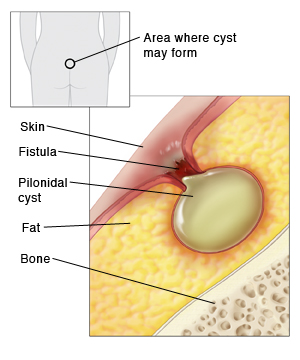Pilonidal Cyst
A pilonidal cyst is a fluid-filled sac found near the base of the spine (tailbone) or top of the buttocks crease. It may look like a pit or small depression. In some cases, it may have a hollow tunnel (sinus tract) that connects it to the surface of the skin. Normally, a pilonidal cyst doesn't cause symptoms. But if it becomes infected, it can cause pain and swelling.

What causes a pilonidal cyst and who gets them?
The cause of pilonidal cysts has been debated since they were first recognized. Most likely, the cause may be a combination of:
-
Ingrown hairs. This happens when a hair is forced under the skin or when a hair follicle breaks open (ruptures).
-
Injury to the area. Injury, rubbing, or skin irritation may cause pilonidal cysts. This can happen from sitting for long periods of time. It can be more common in people who sit or drive a lot for work.
These cysts are often diagnosed in people between ages 16 and 26. But people of any age can have a pilonidal cyst. A person may be born with a cyst but not notice it. These cysts can affect anyone. But they're more common in males, especially those with a large amount of body hair.
Symptoms of a pilonidal cyst infection
A pilonidal cyst may not cause symptoms unless it becomes infected or inflamed. Once a pilonidal cyst becomes infected, it's called a pilonidal abscess. Infection or inflammation from irritation may cause these symptoms:
-
Pain, redness, and swelling of the cyst and area around it
-
Bad-smelling fluid leaking from the cyst
-
Fever
Diagnosing a pilonidal cyst
A pilonidal cyst can be diagnosed by how it looks and by its location. Your healthcare provider will check the suspected cyst to confirm a diagnosis. You'll be told if you need any tests.
Treating a pilonidal cyst infection
Most pilonidal cysts are left alone. But if a cyst becomes infected or inflamed, you need treatment. This may include:
-
Incision and drainage. If needed, the cyst is cut open, and pus and other infected material is allowed to drain.
-
Antibiotic medicines for the infection. Know that medicines don't make the cyst go away, and antibiotics have limited use in treating an abscess. They also won’t keep a cyst from getting infected again.
-
Hot water soaks. These can help draw out the infection and ease pain and itching.
-
Surgery to remove the cyst (excision). This may be done if the infection is severe, doesn't respond to medicine, or keeps coming back. A surgeon cuts and removes the cyst and the tissue around it. Your healthcare provider can tell you more if this is needed.
-
Laser hair removalaround the area. This may decrease the frequency of flare-ups.
Preventing infection
A pilonidal cyst can easily get infected. To help prevent infections:
-
Keep the cyst and nearby skin area clean.
-
Remove hair from the area of the cyst regularly. Ask your healthcare provider about safe hair removal products or procedures.
-
Don't sit in 1 position for long periods of time. This helps to reduce weight and pressure on your tailbone area. Sitting on a special cushion to ease pressure on the tailbone may also help. Ask your healthcare provider where to buy these cushions.
-
Don't wear tight-fitting clothes. Looser clothing can help reduce skin irritation around the cyst.